Yeh Duniya Agar Mil Bhi Jaaye – Guru Dutt
The classic song from the classic film Pyaasa’1957 seems to be the perfect metaphor for Guru Dutt and his life. Something of a pessimist, he committed suicide in 1964 at the age of 39, leaving behind a haunting question – Yeh duniya agar mil bhi jaaye to kya hai. (So, what even if I get the world) It seems senseless that the man who got it all and had the world really at his feet as an acclaimed producer, director, the actor should end up living the lyrics of his song.
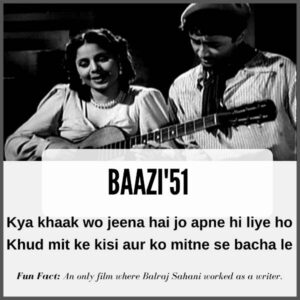 Born Vasanth Kumar Shivashankar Padukone, Guru Dutt trained under Uday Shankar, the famous dancer, thus imbibing a strong aesthetic sense of dance and music. Working as a choreographer at Prabhat film company in Pune, resulted in his meeting Dev Anand and the famous pact wherein Dev Anand, Guru Dutt and Raj Khosla promised to help the other if anyone of them “made it”. It was Dev Anand who “made it first” and who gave Guru Dutt his first break in Baazi’1951 a crime thriller which started a new genre of crime films set in Bombay (now Mumbai) which is sometimes collectively known as “Bombay noir”. Noir is French for black and these crime films showed a dark world which the central character either entered willingly or was pushed into, setting the formula for much of the “gangster films of the 1960s and 1970s.
Born Vasanth Kumar Shivashankar Padukone, Guru Dutt trained under Uday Shankar, the famous dancer, thus imbibing a strong aesthetic sense of dance and music. Working as a choreographer at Prabhat film company in Pune, resulted in his meeting Dev Anand and the famous pact wherein Dev Anand, Guru Dutt and Raj Khosla promised to help the other if anyone of them “made it”. It was Dev Anand who “made it first” and who gave Guru Dutt his first break in Baazi’1951 a crime thriller which started a new genre of crime films set in Bombay (now Mumbai) which is sometimes collectively known as “Bombay noir”. Noir is French for black and these crime films showed a dark world which the central character either entered willingly or was pushed into, setting the formula for much of the “gangster films of the 1960s and 1970s.
Baazi was an instant hit and it was clear to everyone that a major talent had arrived. The story and script, by the actor Balraj Sahni, showed a youth entering the crime world to pay for his sister’s medical expenses but in the process almost losing his humanity and the love of the female doctor who is treating his sister. The superlative music by S.D.Burman complemented Sahir Ludhianvi’s lyrics, with one gem after another which included the teasing “Taqdeer se bigdi hui taqdeer bana le”. Let’s discuss the song and its meaning.
The dancer Leena (Geeta Bali), who is already working for an unknown “Boss”, is teasing Madan (Dev Anand), asking him to take a decision – in fact a “gamble” – when she says “Apne pe bharosa hai to ye daanv laga le”. While he is still indecisive and wondering what to do, whether to enter the gang or not, Leena continues into the second antra which reads Kya khaak wo jeena hai jo apne liye ho (What’s the purpose of living for oneself), Khud mitke kis aur ko mitne se bacha le (Save yourself and someone from being destroyed). When the song ends, Madan makes up his mind and tells Leena “take me to the Boss”. It’s also worthy to note that while the song is going on, Madan is going from the lit foreground to the shadowy mid and dark background, denoting his progression from “light” to “dark”.
All the other songs were hits or at least well known. Geeta Dutt was in full form with 6 out of 8 songs. The remaining 2 songs were split one each between Shamshad Begum and Kishore Kumar. In the case of the Kishore song, Madan is wondering what a turn life has taken since now he has money but not the love and respect of the woman he loves and his family which is why he says “mere labon pe dekho aaj bhi taraane hain”. The song is unique for another reason; this is probably the only one where he sits astride a donkey and merrily sings the song – impossible to imagine later, given Dev Anand’s suave, starry image.
The last song of the film is the climactic song “Suno Gajar kya gaaye” where Madan is about to be shot dead in the club on the Boss’s orders. Leena who knows this is trying to prevent it by singing the clues. Gine chune pal hain tere Jeevan ke (You only have a few moments left of your life)
Dhoom macha le ab din hain milan ke (Enjoy your life as its time for union) O re jeenwale o re bhole bhaale sona na Khona na (Don’t sleep you live innocent man). The camera is intercut between the dancers, Leena, one of the “shooters”, the club manager (Rashid Khan) and Madan wondering what’s going on. Much like the first song Taqdeer se bigdi hui where Leena asked Madan to gamble everything, now its Leena who is trying to save Madan’s life. The “huge close-ups” of the bad guys intercut with an innocent Madan (Dev Anand looking very suave) works even today and has been used in many subsequent films to “build” tension.
Having set the tone with Baazi, Guru Dutt directed yet another “crime thriller” Jaal’1952. Once again, the cast included Dev Anand and Geeta Bali, but this time as a lead pair. “Villain” K. N. Singh played Geeta Bali’s blind brother who helplessly watches his sister Maria, being wooed by the rakish no-gooder Tony (Dev Anand). It’s impossible to imagine Dev Anand doing a negative character today but in Jaal he was a focused criminal, who wants to marry Maria for nefarious purposes.
Once again Guru Dutt shows mastery in song picturizations. Let’s look at the “tandem” song – a song with same tune, sung by two different singers – Ye Raat ye Chandni Phir Kahaan. The Male version sung by Hemant Kumar is about Tony wooing Maria while she is still hesitant and doubtful while he entices with Aaja abhi Mausam hai jawaan.
However, in the female version, Maria has given in to her inner feelings and is now pining for Tony, knowing fully well that there is only pain on the horizon. The lyrics, the music, and the slow tracking camera, the close-ups convey Maria’s emotions in both versions.
After that Guru Dutt could do no wrong. Not only was he directing and acting but he turned producer with Aar Paar’ 1954, yet another “Bombay Noir” thriller. As a producer, Guru Dutt had the choice of the music director and with OP Nayyar, the meeting of minds was perfect. One peppy number after another followed like a torrent in Aar Paar which was about a taxi driver Kalu (Guru Dutt) getting drawn into the world of crime while being prevented by his friend and sidekick Rustam (Johnny Walker). Kalu of course moves in the dark world of crime through subterranean clubs where a dancer (Shakila) entices and warns him “Baabuji dheer chalna, pyaar me zara sambhalna”.
Aar Par was a hit, no doubt helped by the hit musical soundtrack. But Guru Dutt surpassed himself with his next hit Mr and Mrs. 55 (1955), a romantic comedy about a “husband for hire” who falls in love with the woman with whom he has entered into a contract as a husband so that she won’t lose her inheritance. The soundtrack consists of one hit after the other like Dil par hua aisa jaado (Rafi), Thandi hawa kaali ghata aa hi gayi jhoom ke (Geeta Dutt), Chal diye bandanawaaz (Rafi-Geeta), Udhar tum haseen ho idhar dil jawan hai (Rafi-Geeta), jaane kahan mera jigar gaya jee (Rafi-Geeta), Neela aasmani (Geeta). But probably the finest picturization is reserved in this film for the most underrated song, Meri duniya lut rahi thi aur mai khamosh tha (Rafi), a personal all-time favorite of this writer.
Preetam (Guru Dutt) knows that the contract is at the end and he can no longer convey his real feelings to Anita (Madhubala). While he is walking in a dark street, a group of street merchants get together and sing the song. The lyrics are also important and worth looking at Meri duniya lut rahi thi aur mai khamosh tha (I remained silent while my world was being looted) Tukde tukde dil ke chunta kisko itna hosh tha (Where was the sense to collect the broken pieces).
Preetam is silently staring at the roadside singers as they act out the loss of love – in this case, they are just expressing his inner feelings when they sing: Aankh me aansun the, jal raha tha dil jigar (Tears in my eyes, my heart was burning), Ro rahi thi hasratein, chup chaap tha mai bekhabar (Hopes cried, but I was silent and clueless), Kaise aata hosh me jo pehle hi madhosh tha (How can someone, already senseless, come to his senses).
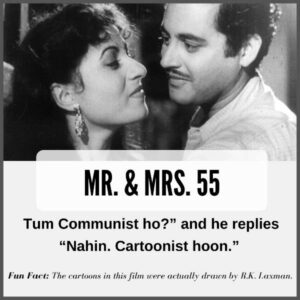 Majrooh Sultanpuri’s lyrics in the film range from the frivolous through romantic to this searing loss. This is a beauty that is not discussed much and perhaps deserves much more exposure given that it comes at a vital space in the film. This is song picturization par excellence.
Majrooh Sultanpuri’s lyrics in the film range from the frivolous through romantic to this searing loss. This is a beauty that is not discussed much and perhaps deserves much more exposure given that it comes at a vital space in the film. This is song picturization par excellence.
Two years later in 1957, his magnum opus Pyaasa was released to much acclaim. Each and every song is a gem and lesson in song picturization, that ends with the literally rousing Ye duniya agar mil bhi jaaye to kyaa hai where the poet Vijay who was crucified in real life is now being praised and worshipped after his supposed death in an accident.
Pyaasa also saw the last pairing of S.D.Burman and Sahir Ludhianvi over an issue “who was the creator of the song”. Both were geniuses in their own way and it is apparent in the way in which there are “unplugged” Rafi solos, without any instruments, which lend weightage to Sahir’s incendiary lyrics. Pyaasa also showed a deep social consciousness in Nehruvian India, by showing all was not well and educated youth were still struggling to get a decent job. The direct slap on the Government and its inability to see the situation was given in the song “Jinhe naaz hai Hind par woh kahaan hai” as Sahir / Rafi cataloged one issue after another in post-independent India.
Even a frivolous song like “Sar jo tera chakraaye´ is picturized well as the wandering massager cites the various reasons why anyone should have their head massaged by him and his “maalish”
A Bengali style ‘kirtan’ is converted to an expression of the streetwalker Gulabo’s love, as she longs for the understanding and love of the poet-hero who is considered a loser by the world but into whose heart she has seen and wished a place for herself. While the lyrics of the “kirtan” sound like Radha calling for Giridhar, it’s clear from the picturization that this isn’t so as Gulabo is pining for Vijay in the same way Radha is pining for her Giridhar.
With Pyaasa being a critical and commercial hit, Guru Dutt couldn’t do any wrong and went ahead with the ambitious Kagaz ke Phool’ 1957 – an excoriating look at the rise and fall of a film director Suresh Sinha and through him at the film industry. The world puts him on a pedestal when he is successful and utterly discards him when he is down and out. The film flopped badly. No doubt this is a reflection of two things – the audience and the industry itself. The audience of those days always wanted their dreams and couldn’t tolerate the downward slide of events in the film. The hero and heroine weren’t worthy of being worshipped or adored as they were humans with flaws. The industry of course doesn’t like to take a harsh look at itself. Most such films like ‘Sone ki Chidiya’, ‘Kagaz ke Phool’ were rejected by the audience as they didn’t show the industry in a wholesome light.
‘Kagaz ke Phool’ is however a masterclass in film making, especially the cinematography of V K Murthy who used multiple lights from various angles to create the “rays and beams of light” in the classic song “Waqt ne kiya kya haseen situm”. This is yet another great song picturization and it’s better seen than described as Kaifi Azmi’s lyrics about the lead couple being unable to be together in this life is brought about on screen. Neither character sings. yet the scene works far better with each character staring into the camera and hoping against hope that the other will take the lead, yet going their ways by the end of the song.
This was the last film directed by Guru Dutt. He however remained producer and had two major hits with ‘Chaudvin ka Chand’ and ‘Sahib, Bibi aur Ghulam’. In spite of encouragement from his friends Badru (Johny Walker), Dev Anand, Abrar Alvi, and other talented giants, his pessimism overcame his general zest for life. Sad. Today his films are considered masterclasses in film making as he was a Director who was the true “author” of the film in every which way one can look at it.
A quick look at Guru Dutt’s films as Director; we can easily make a top 5 top 10 top 20 song list from these.
- 1951 – Baazi
- 1952 – Jaal
- 1953 – Baaz
- 1954 – Aar Paar (also producer)
- 1955 – MR and Mrs 55
- 1956 – Sailaab
- 1957 – Pyaasa (also producer)
- 1958 – kaagaz ke Phool (also producer)






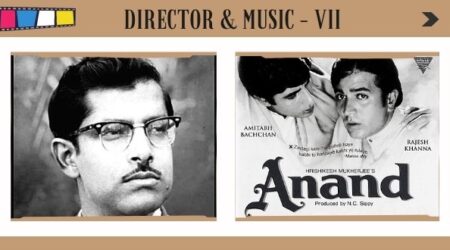

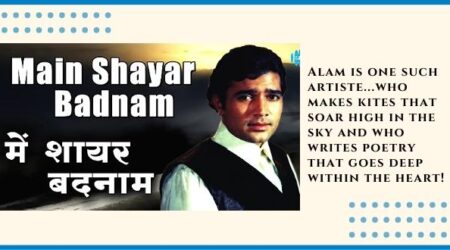
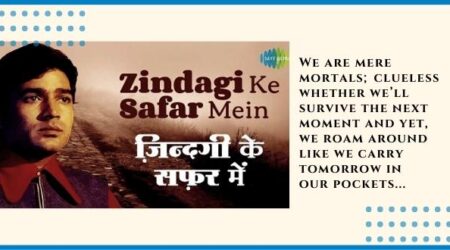
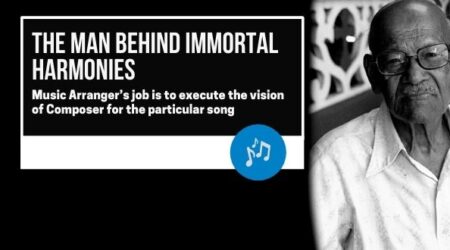
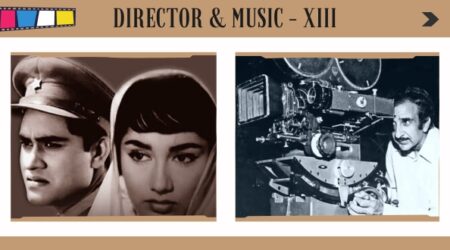


Comments (7)
Excellent write up Sir.
Excellent compilation. Very informative. Keep this work continued. We need to preserve the beautiful past. All the best….!!
Excellent. Informative. Thanks to Dinesh Ghate ji and Swar Aalap for this initiative. Keep up.
Simply superb analysis
excellent analysis working very hard
very helpful nature Dinesh Ghate.
God bless u.
It is still not clear that Guru Dutt comitted suicide.
Most probably liquor/ drugs together caused his death .
It cannot be overlooked or underestimated the number of songs that Rafi sahib rendered in films of Mr Dutt and what phenome hits they became. Unparalleled record